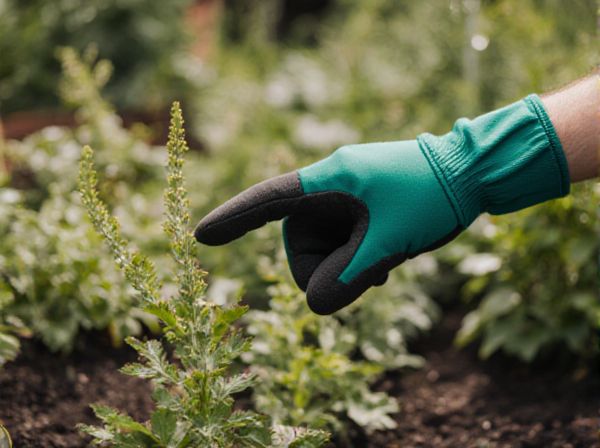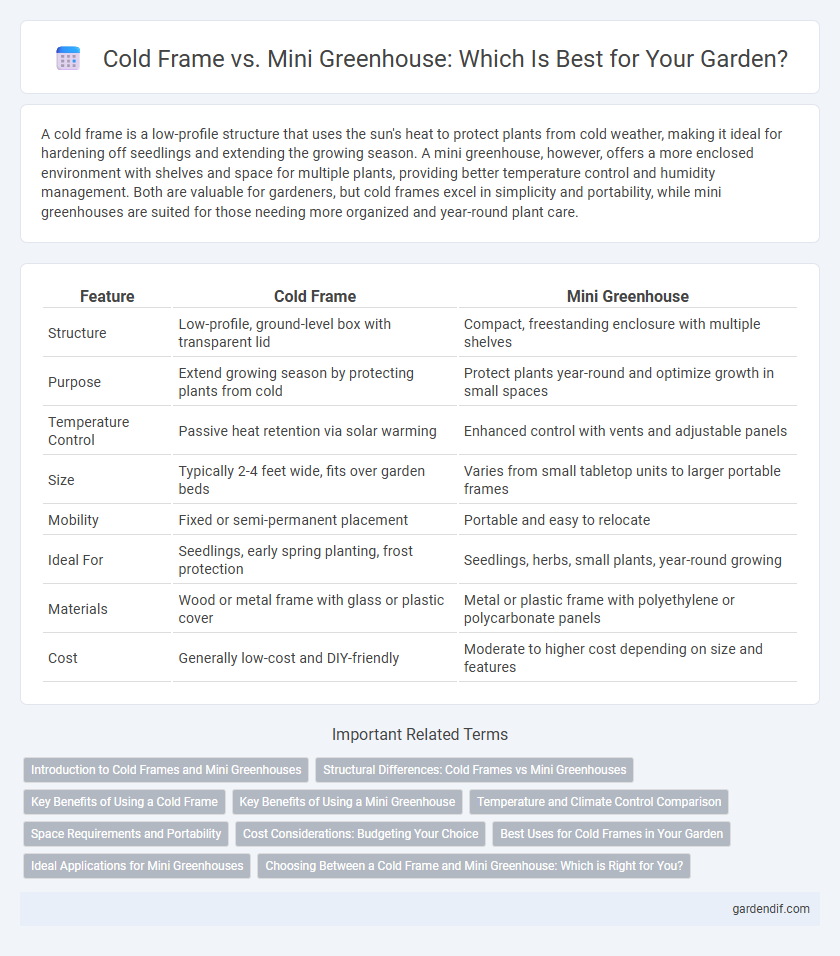
Cold Frame vs Mini Greenhouse Illustration
A cold frame is a low-profile structure that uses the sun's heat to protect plants from cold weather, making it ideal for hardening off seedlings and extending the growing season. A mini greenhouse, however, offers a more enclosed environment with shelves and space for multiple plants, providing better temperature control and humidity management. Both are valuable for gardeners, but cold frames excel in simplicity and portability, while mini greenhouses are suited for those needing more organized and year-round plant care.
Table of Comparison
| Feature | Cold Frame | Mini Greenhouse |
|---|---|---|
| Structure | Low-profile, ground-level box with transparent lid | Compact, freestanding enclosure with multiple shelves |
| Purpose | Extend growing season by protecting plants from cold | Protect plants year-round and optimize growth in small spaces |
| Temperature Control | Passive heat retention via solar warming | Enhanced control with vents and adjustable panels |
| Size | Typically 2-4 feet wide, fits over garden beds | Varies from small tabletop units to larger portable frames |
| Mobility | Fixed or semi-permanent placement | Portable and easy to relocate |
| Ideal For | Seedlings, early spring planting, frost protection | Seedlings, herbs, small plants, year-round growing |
| Materials | Wood or metal frame with glass or plastic cover | Metal or plastic frame with polyethylene or polycarbonate panels |
| Cost | Generally low-cost and DIY-friendly | Moderate to higher cost depending on size and features |
Introduction to Cold Frames and Mini Greenhouses
Cold frames are low, transparent structures that create a microclimate to protect young plants from cold weather, extending the growing season by retaining soil warmth and moisture. Mini greenhouses offer a compact, enclosed environment with better temperature and humidity control, often featuring shelves or compartments for organized seed starting and plant propagation. Both structures serve to shield plants from harsh conditions, but mini greenhouses provide more versatility and space optimization for gardeners with limited area.
Structural Differences: Cold Frames vs Mini Greenhouses
Cold frames feature low-profile, hinged lids with transparent panels designed to trap heat and protect seedlings directly on the ground, while mini greenhouses have taller, more vertical structures with multiple shelves and zippered or hinged doors to allow better access and ventilation. Cold frames typically use robust wood or plastic frames with glass or clear plastic covers, offering simpler insulation, whereas mini greenhouses often incorporate lightweight metal or PVC frames with polyethylene or PVC covers for enhanced portability and versatility. The structural design differences impact the microclimate control, space utilization, and suitability for different types of plants and growing stages.
Key Benefits of Using a Cold Frame
Cold frames provide superior insulation and protection for seedlings by trapping solar heat, which extends the growing season without the need for electricity. They are compact and highly durable, making them ideal for gardeners with limited space seeking to harden off plants or start early crops. Compared to mini greenhouses, cold frames offer a simpler, cost-effective solution focused on temperature regulation and frost protection.
Key Benefits of Using a Mini Greenhouse
A mini greenhouse offers superior temperature control and protection from harsh weather compared to a cold frame, enabling extended growing seasons and healthier plant development. Its transparent design maximizes sunlight exposure while providing ventilation options to regulate humidity and prevent mold growth. Compact yet versatile, mini greenhouses accommodate a wider variety of plants, making them ideal for gardeners seeking an efficient solution for year-round cultivation.
Temperature and Climate Control Comparison
Cold frames maintain lower temperatures by harnessing natural sunlight and insulation, making them ideal for early seed starting in mild climates. Mini greenhouses offer enhanced temperature regulation with built-in ventilation and heaters, providing better protection against frost and fluctuating weather conditions. Both structures extend growing seasons, but mini greenhouses deliver superior climate control for diverse plant needs.
Space Requirements and Portability
Cold frames require minimal space as they are low-profile structures designed to fit directly on garden beds, making them ideal for small gardens or limited areas. Mini greenhouses, though slightly larger with vertical frames and multiple shelves, offer increased storage capacity but need more floor space. Both are portable, but cold frames are typically easier to move due to their smaller, lighter build.
Cost Considerations: Budgeting Your Choice
Cold frames generally offer a more affordable option for gardeners, with prices ranging from $30 to $150 depending on size and materials. Mini greenhouses tend to be more expensive, typically costing between $50 and $300, reflecting their larger size and additional features such as ventilation and shelving. When budgeting, consider the balance between initial investment and long-term benefits like durability, climate control, and plant variety support.
Best Uses for Cold Frames in Your Garden
Cold frames are ideal for extending the growing season by protecting seedlings and hardening off young plants in cool climates. Their low-profile design allows them to retain heat efficiently, making them perfect for starting vegetables and herbs early in spring. Gardeners benefit from cold frames by creating controlled microclimates that promote strong root development and reduce transplant shock.
Ideal Applications for Mini Greenhouses
Mini greenhouses are perfect for urban gardeners with limited space, providing a controlled environment for seed starting, protecting delicate plants from frost, and extending the growing season. They offer versatility for growing herbs, flowers, and small vegetables on balconies, patios, or windowsills. Compact design and easy portability make mini greenhouses ideal for hobbyists seeking efficient microclimate management.
Choosing Between a Cold Frame and Mini Greenhouse: Which is Right for You?
Cold frames offer a low-cost, space-efficient option for extending the growing season by protecting plants from frost, while mini greenhouses provide a larger, enclosed environment ideal for seed starting and tender plant cultivation. Consider your available space, target plants, and budget when choosing between these structures; cold frames suit small-scale, hardy plant protection, whereas mini greenhouses support diverse plant growth with better temperature and humidity control. Both options enhance garden productivity, but aligning their features with your gardening goals ensures optimal results.
Cold Frame vs Mini Greenhouse Infographic

 gardendif.com
gardendif.com